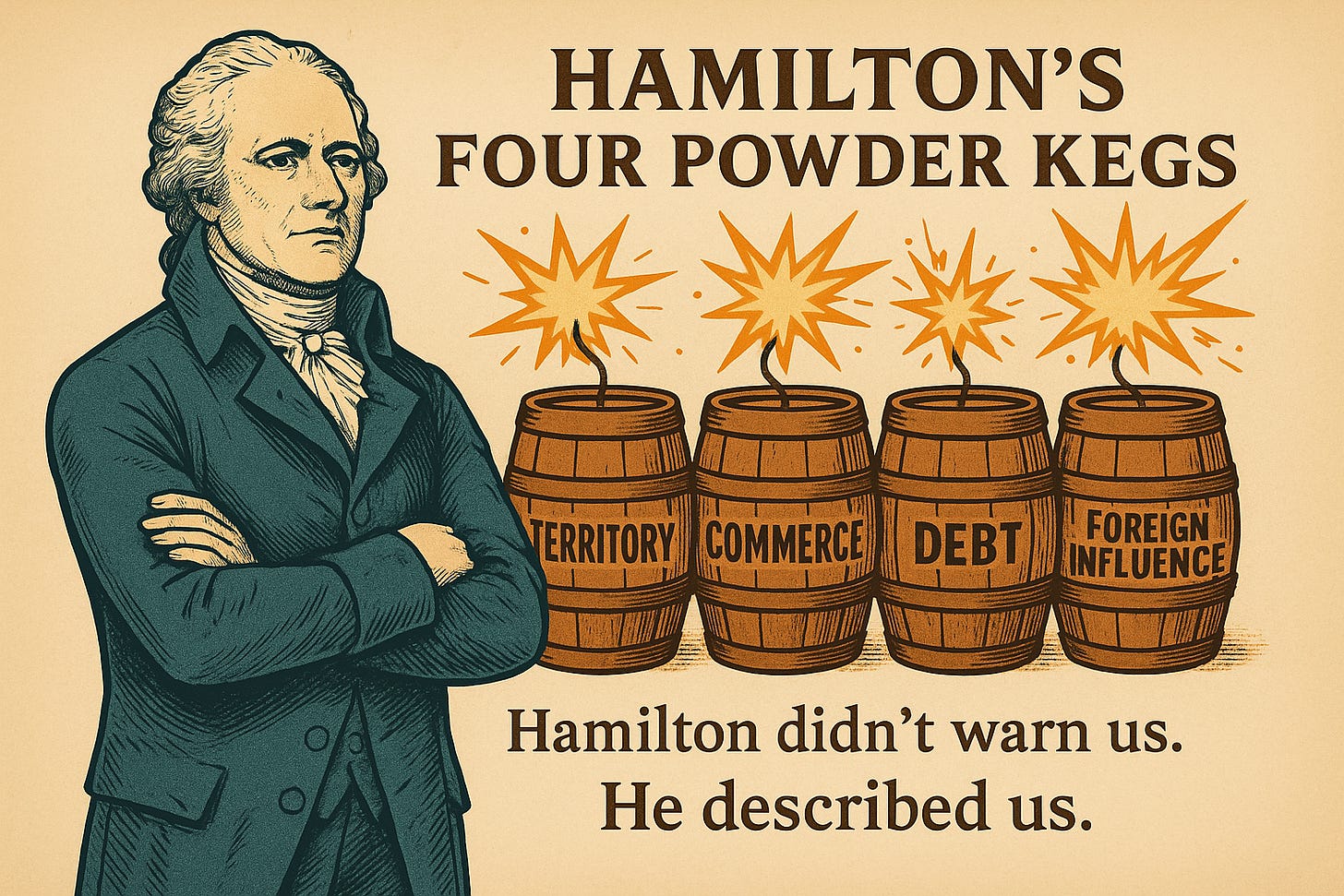It started with water.
The Rio Grande ran low, and fingers pointed high. Texas blamed New Mexico for overusing what nature barely provided. Lawsuits followed. Threats of retaliation weren’t far behind. The headlines called it a regional dispute. But something deeper stirred under the surface. A question older than the republic: What happens when the states stop acting like one country?
This isn’t a new fight. It’s the oldest one. And Alexander Hamilton saw it coming like a storm on the horizon.
In Federalist No. 7, Hamilton didn’t just write about federalism. He warned of a future where each state pursued its own ambitions, rivalries, and foreign alignments. The absence of a binding center meant conflict wasn’t just likely, it was inevitable. “Disputes and controversies between the states,” he wrote, “have been numerous.” Without unity, those disputes would turn into something far more dangerous.
It was a prediction. Today, it's a diagnosis.
In 2025, we’re watching the United States test that diagnosis in real time. Water wars. Trade battles. Interstate legal challenges. Foreign actors exploiting digital and economic fractures. The disunion Hamilton feared isn’t a hypothetical anymore. It’s a pattern. One that threatens to unravel the economic and legal scaffolding that makes liberty possible.
And yet, through all of this, the Constitution still holds. The framework is bruised but not broken. We still have a path back. But only if we understand what Hamilton understood: peace and prosperity aren’t born from mutual respect alone. They require structure. Rules. Incentives. And when needed, consequences.
Let’s break down how we got here—and how we can find our way back.
The Ghosts of Hamilton's Past Are Tweeting From the Present
Hamilton warned us what happens when states act like rival fiefdoms. He called out four powder kegs:
Territorial disputes
Commercial rivalry
Debt disputes
Foreign meddling
Last month, Texas and New Mexico reignited a legal dispute over water rights. The fight centers on the Rio Grande, and both sides claim the other is gaming the system. Meanwhile, California is threatening trade retaliation against neighboring states over environmental policies that clash with its carbon credit empire.
Add in sanctuary city laws, state-level immigration pacts, state-run cryptocurrency pilots, and open defiance of federal regulations, and what you’ve got is a fifty-piece jigsaw puzzle that no longer fits together.
Hamilton saw it coming. He wrote that without strong federal glue, these conflicts would “invite aggressions” and open the door to outside influence. Today, we’re not worried about British spies. It’s TikTok data mines, covert Chinese land buys, and foreign entities bankrolling media narratives and nonprofit legal warfare. The uniforms have changed, but the strategy hasn't.
Rival States, Rival Economies
Hamilton painted a scenario where economic jealousy would tear the country into pieces. “The competitions of commerce would be another fruitful source of contention,” he warned. We’re living that slow-motion implosion.
California’s economy could function as its own country. So could Texas. New York isn’t far behind. And increasingly, they act like it.
Each of these mega-states sets its own rules for everything from emissions to employment law, creating economic silos. Companies navigate a legal labyrinth just to operate across state lines. Entrepreneurs are punished for wanting to scale. And middle-class Americans get whiplash from a geography-based caste system.
Hamilton’s fear wasn’t just about inconvenience. He knew that when economies become rivals, retaliation follows. Tariffs, restrictions, and boycotts aren’t far behind. It may not be a tariff today, but try getting your products into certain states without navigating local red tape, niche taxes, or outright bans. It’s happening. Quietly. Daily.
At the New York ratifying convention, delegates openly worried about these tensions. One speaker cited Vermont's disputed status as proof: “If we cannot agree who owns the land beneath our feet, how can we share laws above it?”
The Debt Divide
Hamilton also zeroed in on fiscal instability. “The public debt of the Union would be a further cause of collision between the separate States,” he wrote. And here we are.
Remember the stimulus wars? Some states hoarded federal pandemic funds, while others spent them like Monopoly money. As repayment deadlines hit and inflation stretches wallets thin, resentment is building.
Anti-Federalist No. 7 countered Hamilton with a harsh warning: “The extensive powers vested in Congress, at the expense of the state governments, will inevitably produce a violent and unnatural conflict of interest and authority.”
In other words, they saw centralization as the enemy of liberty. But what both sides understood—and feared—was the toxic mix of unequal burdens and shared obligations. That tension is playing out today as fiscally responsible states push back against what they see as federal redistribution schemes that reward recklessness.
As of this year, fourteen states are flirting with insolvency. A few are outright begging for federal bailouts. Others, more fiscally restrained, are saying, “Not with our money.” This isn’t just red vs. blue. It’s solvent vs. reckless. And it's pulling at the seams of any shared sense of responsibility.
The New Foreign Entanglements
Foreign manipulation in 1788 meant European powers exploiting our young republic. In 2025, it means economic and digital infiltration. Hamilton warned us: “The prospect of present loss or advantage may tempt the governing party in one or two states to commit aggressions on the rights of their neighbors.” He feared foreign actors would exploit those aggressions.
Multiple states have inked their own international trade pacts, often in defiance of national policy. Some are courting foreign investors whose interests clash with American industries or land use integrity. We have states selling off farmland to overseas corporations while others try to ban it. There’s no unified front.
Now add in digital warfare. When foreign platforms amplify local unrest, target state elections with misinformation, or skew regional economic data, they’re not just watching the house burn. They’re handing out matches.
A Nation of Fifty Different Realities
So, where does this all leave us?
The Supreme Court has become the emergency brake for nearly every interstate dispute. But even that brake is wearing thin. Court decisions are interpreted differently depending on the state you’re standing in. Precedent is no longer national. It’s optional.
The Constitution was supposed to be the glue. And it still can be. But only if we stop treating federalism like a buffet menu. You don’t get to pick the parts you like and ignore the rest. That isn’t freedom. That’s chaos.
Deep Policy Solutions: Liberty, Grounded in Reality
Reaffirm Federalism Through Market Discipline.
Deep in pension debt, states like Illinois and New Jersey continue to expect federal support to plug gaps caused by years of fiscal mismanagement. A 2023 Cato Institute study argues that fiscal federalism only works when states bear the full costs of their policies. Bailouts and federal backstopping undermine accountability. The solution? Phase out unconditional federal transfers. If New York wants to build a single-payer system or California wants to experiment with universal basic income, let them, but make them fund it alone.Enforce Interstate Commerce Protections.
California has imposed vehicle emissions standards that effectively dictate what cars can be sold nationwide. Florida has banned the import of certain agricultural products over pesticide disputes. These aren't just local quirks; they violate the constitutional guarantee of free interstate commerce. Reason Foundation has called for a fast-track judicial review process to challenge protectionist laws. Congress should back this up with legislation authorizing the DOJ to act when states block the free flow of goods and services.Constitutionalize Spending Limits and Transparency.
Texas caps state budget growth at the rate of inflation plus population growth, and Florida imposes a balanced budget requirement. Compare that with states like Connecticut, which routinely bust their caps with accounting gimmicks. According to Mercatus Center research, embedding real, enforceable limits in state constitutions prevents cyclical crises. Congress, which frequently attaches strings to federal funding, can make limits a prerequisite for receiving federal infrastructure and education funds. Of course, they’d have to start with the federal budget first.Bolster Horizontal Federalism With Binding Compacts.
States are already cooperating informally on issues like occupational licensing and emergency response, but these compacts lack enforcement teeth. Instead, states should sign binding agreements reviewed by third-party arbitrators. Think multi-state pacts to recognize medical credentials or shared infrastructure agreements that prevent duplicate regulation. Reason scholars recommend embedding these in state law and shielding them from unilateral withdrawal.Create a Competitive Federalism Index.
Transparency matters. Inspired by Cato’s Freedom in the 50 States project, a competitive index could rank states by tax burden or regulation and by how often they defy constitutional norms. It could include metrics like fiscal solvency, regulatory spillover, and intergovernmental lawsuits. Let voters and investors make decisions with their feet and their wallets.
Final Pour
Hamilton understood one very important point: freedom without order isn’t freedom. It’s entropy. The kind of entropy that looks a lot like where we’re heading now. But here’s the good news. The Union is still intact. The framework still holds. And we still have a choice.
We can drift into fractured irrelevance, each state an island fighting over scraps. Or we can remember why the Constitution mattered in the first place.
It wasn't just about preventing tyranny. It was about making peace profitable, freedom sustainable, and ensuring that what we built together didn’t collapse under the weight of what we refused to share.
That’s not just history. That’s tomorrow.
And tomorrow is still ours to fix.






This work is so valuable and it reminds me of a similar series of articles, "How the System Works" authored by Charles Mann in the magazine, The New Atlantis. Mann is equally concerned about the same thing - society wide forgetting about the complex systems of interdependence that we have built to supply clean water, abundant food, cheap energy, and public health. We need to re-imagine how and why we teach people of all ages the decades-long efforts to build and maintain these systems, including political interdependence, and what it will take from each of us to continue this effort.